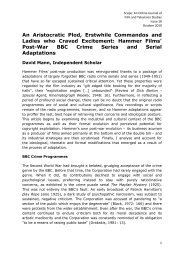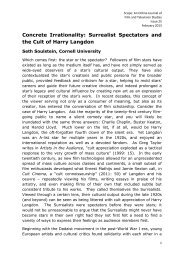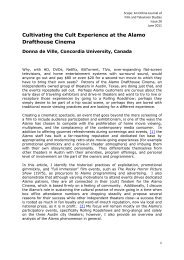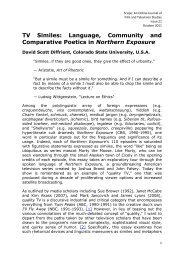Chapter in e-Book - Scope - University of Nottingham
Chapter in e-Book - Scope - University of Nottingham
Chapter in e-Book - Scope - University of Nottingham
You also want an ePaper? Increase the reach of your titles
YUMPU automatically turns print PDFs into web optimized ePapers that Google loves.
Ia<strong>in</strong> Robert Smith<br />
<strong>in</strong>g cultural borrow<strong>in</strong>gs across a diverse range <strong>of</strong> media and through a diverse<br />
range <strong>of</strong> methodologies.<br />
When video artist Charles Lum mixed sequences from the horror film Carrie<br />
(1976) with images and sounds from gay pornography <strong>in</strong> his experimental short<br />
Indelible (2004); or when director Sanjay Gupta reworked elements <strong>of</strong> Reservoir<br />
Dogs (1992) <strong>in</strong> the Bollywood musical Kaante (2002); or when the Beastie Boys<br />
recreated scenes from the Italian comic book adaptation Danger: Diabolik<br />
(1968) <strong>in</strong> the music video to ―Body Mov<strong>in</strong>‘,‖ they were all appropriat<strong>in</strong>g elements<br />
from prior cultural texts for use <strong>in</strong> the creation <strong>of</strong> new works. Br<strong>in</strong>g<strong>in</strong>g together<br />
<strong>in</strong>sights from across the discipl<strong>in</strong>es, this collection develops our academic models<br />
<strong>of</strong> adaptation and appropriation <strong>in</strong> order to consider what is at stake when these<br />
artists borrow and transform elements from pre-exist<strong>in</strong>g work <strong>in</strong> new cultural<br />
texts.<br />
The issue is organised <strong>in</strong> four sections, each deal<strong>in</strong>g with a different form <strong>of</strong> cultural<br />
borrow<strong>in</strong>g. Part I exam<strong>in</strong>es ―Hollywood C<strong>in</strong>ema and Artistic Imitation‖ and<br />
provides three complimentary historical accounts <strong>of</strong> the development <strong>of</strong> adaptation<br />
with<strong>in</strong> US c<strong>in</strong>ema. First, IQ Hunter, <strong>in</strong> his article ―Exploitation as Adaptation,‖<br />
complicates notions <strong>of</strong> textual orig<strong>in</strong>ality by exam<strong>in</strong><strong>in</strong>g the whirl <strong>of</strong> <strong>in</strong>tertextual<br />
references that fed <strong>in</strong>to Jaws (1975) and the cycle <strong>of</strong> exploitation films<br />
that followed, which he terms ―Jawsploitation.‖ Function<strong>in</strong>g as a thorough catalogu<strong>in</strong>g<br />
<strong>of</strong> the Jaws meme from Piranha (1978) to Deep Blue Sea (1999), the article<br />
also <strong>of</strong>fers a productive model for understand<strong>in</strong>g exploitation c<strong>in</strong>ema as itself<br />
a mode <strong>of</strong> adaptation. Jason Scott then takes us back to an earlier <strong>in</strong>carnation<br />
<strong>of</strong> artistic imitation <strong>in</strong> Hollywood, historiciz<strong>in</strong>g its development <strong>in</strong> ―The Character-Oriented<br />
Franchise: Promotion and Exploitation <strong>of</strong> Pre-Sold Characters <strong>in</strong><br />
American Film, 1913-1950.‖ While most discussions <strong>of</strong> franchises and synergy<br />
focus on the contemporary media landscape, this is the first article to concentrate<br />
its sole attention on the role <strong>of</strong> pre-sold characters -- from Dick Tracy to<br />
Superman -- <strong>in</strong> the development <strong>of</strong> the early Hollywood franchise system.<br />
Round<strong>in</strong>g <strong>of</strong>f this section is Stijn Joye with ―Novelty Through Repetition: Explor<strong>in</strong>g<br />
the Success <strong>of</strong> Artistic Imitation <strong>in</strong> the Contemporary Film Industry, 1983-<br />
2007,‖ build<strong>in</strong>g on current work <strong>in</strong> the field <strong>of</strong> adaptation studies by explor<strong>in</strong>g<br />
the phenomenon from a quantitative perspective. Exam<strong>in</strong><strong>in</strong>g an extensive data<br />
set from 1983-2007, Joye helps lend credence to the <strong>of</strong>t asserted yet rarely<br />
substantiated notion that adaptations and remakes have become <strong>in</strong>creas<strong>in</strong>gly<br />
prevalent <strong>in</strong> the contemporary film <strong>in</strong>dustry.<br />
Just as Part I <strong>in</strong>vestigates the historical development <strong>of</strong> artistic imitation <strong>in</strong> Hollywood,<br />
then Part II looks to the future and exam<strong>in</strong>es the contemporary practice<br />
<strong>of</strong> ―Found Footage and Remix Culture.‖ Open<strong>in</strong>g with Eli Horwatt‘s article ―A<br />
Taxonomy <strong>of</strong> Digital Video Remix<strong>in</strong>g: Contemporary Found Footage Practice on<br />
the Internet,‖ the section provides <strong>in</strong>sights <strong>in</strong>to the complex processes <strong>of</strong> adaptation<br />
that pervade new media technologies. Horwatt‘s contribution <strong>of</strong>fers both a<br />
useful taxonomy <strong>of</strong> the different form <strong>of</strong> digital video remix<strong>in</strong>g from ―Political<br />
Remix Video‖ to ―Trailer Mash-Ups‖ and traces the antecedents to this trend <strong>in</strong><br />
avant-garde found-footage filmmak<strong>in</strong>g practice. Next, Emma Cocker‘s article<br />
―Ethical Possession: Borrow<strong>in</strong>g from the Archives‖ focuses on the Italian filmmak<strong>in</strong>g<br />
team Yervant Gianikian and Angela Ricci-Lucchi, who utilise found-<br />
2






